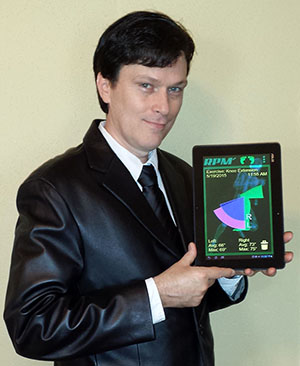Roden develops software for smart insole
For Timothy Roden, a Lamar University associate professor of computer science, his role in transforming an idea into a reality is revolutionizing both the medical and athletic fields.
Over a two-year period, Roden worked to develop the invention with MedHab, LLC, a privately held company focused on developing athletic and medical devices to offer customized physical rehabilitation and sport-enhancing protocols for patients.
“I had never seen or been involved in anything like this before,” Roden said. “When I was approached to be a part of this innovative project, my curiosity was peaked.”
 Roden is first author on the paper, “Development of a Smart Insole Tracking System for Physical Therapy and Athletics,” which was presented during the 7th International Conference on PErvasive Technologies Related to Assistive Environments (PETRA) on May 27-30, 2014 in Greece.
Roden is first author on the paper, “Development of a Smart Insole Tracking System for Physical Therapy and Athletics,” which was presented during the 7th International Conference on PErvasive Technologies Related to Assistive Environments (PETRA) on May 27-30, 2014 in Greece.
“After President and CEO of MedHab, Johnny Ross Jr., had extensive knee surgery, he noticed some of the rehabilitation techniques used in physical therapy were inefficient,” Roden said. “These observations resulted in an idea about creating technology that would enable a patient to attend physical therapy less, yet he or she would progress faster and the physician would obtain more accurate evaluations.
Originally, Ross came up with the idea to create a digital sensor-enabled smart shoe insert with the hope that this invention would enhance physical therapy. However, the design has found applications in both healthcare and athletic training.”
In 2011, a patent application for the smart insole, known as the StepRite® system, was approved.
“The wireless smart insole tracking system technology allows healthcare professionals to remotely monitor patients undergoing physical rehabilitation,” he said. “However, the system also serves as a diagnostic tool where the physical therapist can customize therapy for each patient’s individual need and evaluate abnormalities in gait and range of motion before surgery.”
While a department chair at Angelo State University, Roden served as the primary software developer on the smart insole tracking system.
“When developing software for the system, we came across challenges in creating the smartphone applications to interface to the foot-bed device,” he said. “There were no similar applications from which we could compare. The system was original.”
The medical device offers a secured user interface and wireless communication by utilizing smart phones, Roden said.
“I helped write software that collects data while patients are exercising, and it is then uploaded to a Health Insurance Portability and Accountability Act (HIPAA) secured server,” he said. “From there, the raw data is translated into charts. The remote transmission of data provides the physical therapist information on the patient’s progress. This technology allows patients to perform the rehabilitation exercises in their home and can allow their healthcare providers to wirelessly modify rehabilitation protocols.”
While designing the mobile phone application, Roden said the goal was to create a simple, user-friendly system.
“The system provides both audible and onscreen prompts to the user when performing exercises,” he said. “The physician selects the patient’s exercise regimen which is then downloaded to the smartphone. After the exercise is completed, the data is recorded and is transmitted to the server for analysis. Physicians and patients see a different view of the data. The server dashboards for patients show a more simplified view.”
After realizing the computer enhanced insole had applications in the athletic market, RPM² (Remote Performance Measurement/Monitoring), was born.
“Utilizing the same insole hardware, RPM² was developed to augment athletic performance,” he said. “The device provides measurements of the lower extremities and offers feedback on an athlete’s gait, range of motion, force and power. This allows athletes to prevent injuries and muscle strains that inhibit performance and rehabilitation.”
Roden said the product is evolving and has received attention.
“Using today’s standards in gait analysis, the device has undergone testing at Texas A&M University Corpus Christi,” he said. “Also, RPM² has established a partnership with Michael Johnson, Olympic champion, and his athletic training organization, Michael Johnson Performance, Inc. His team tested the device and believes it will transform how athletes train.”
Roden said helping to develop the smart insole tracking system has been one of the most interesting and rewarding projects he has embarked on.
“A lot of people came together to make this idea a functional reality,” he said. “The team responsible for creating these products is quite diverse, each person bringing knowledge from a different field of study. I had not worked on anything like this before. The creation of the StepRite and RPM² devices can help the user achieve an enhanced rehabilitative or athletic performance. These products have the potential to transform both the medical and athletic fields.”


